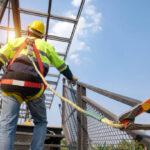Using roof crossover stairs is safer for traversing the rooftop construction site. All rooftops are different, presenting unique fall hazards and other challenges for workers with cables, parapets, pipes, etc. Unfavorable weather might worsen risks by producing slick surfaces that could endanger employees. The appropriate fall protection system is crucial in this situation.
OSHA platform requirements!
OSHA defines the requirements for creating safe workspaces for workers working at construction sites. The regulations will be updated with the new amendments to ensure that crossover stairs or ramps provide workers with a completely safe working area before implementing these.
Check out the several key OSHA requirements:
Guardrails
According to OSHA regulations, guardrails should be implemented around the working surface.
The conditions to be followed are:
- When the height of the work site exceeds four feet.
- The guardrail should be at least forty-two inches high.
- Railing or guardrail should be implemented if the stairs are open on all sides.
- It should withstand 200 pounds of force that can be applied from any direction.
- The stairs should be 22 inches wide, and the open riser should be 8 inches high.
Guardrails should be installed with all these conditions in mind to meet the industry regulations for the workers’ safety.
Selecting the right type of crossover stair!
- Evaluate the space constraints
Check the available space present in your facility. One can opt for ladder crossovers if limited space is available, while stair crossover is a great option if there is enough space. A stair crossover is always a better option with more safety and better ergonomics than ladder crossovers. Specific ladders with higher conveying height are a better option for high-traffic areas. One should also look for a stair with features that are easy to use and comfortable for frequent crossings. While for occasional crossing usage, one is not required to think about these features as much.
- Loading requirements
The crossover stair should be raised enough to avoid interference if it is needed to move big or heavy objects.
- Safety considerations
Stair crossovers are always a safer option with their stable footing option therefore, if the work site is risky or slippery surface then ladder crossover can cause fall hazards. The safety of workers should always be the prime duty; therefore, make sure you consider all the safety standards mentioned by OSHA regulations that should be specifically implemented in your industry.
- Frequency of traffic
One has to consider how often an employee is required to cross it. For high-traffic areas, a stair with high height is an ideal option. Ease of use and the ability to handle high traffic comfortably are the features to consider when choosing a crossover stair.
Conclusion!
Rooftop stairs are important for accessing the rooftop and completing maintenance tasks. Following the OSHA regulations is essential for crossover stains because poorly planned stairs can cause fall hazards that can result in injuries. Not only should the stairs be designed with quality material, slip-resistant features or sturdy handrails, but the length, width, and other things should also be considered, as mentioned above, for the complete safety of the employees.

